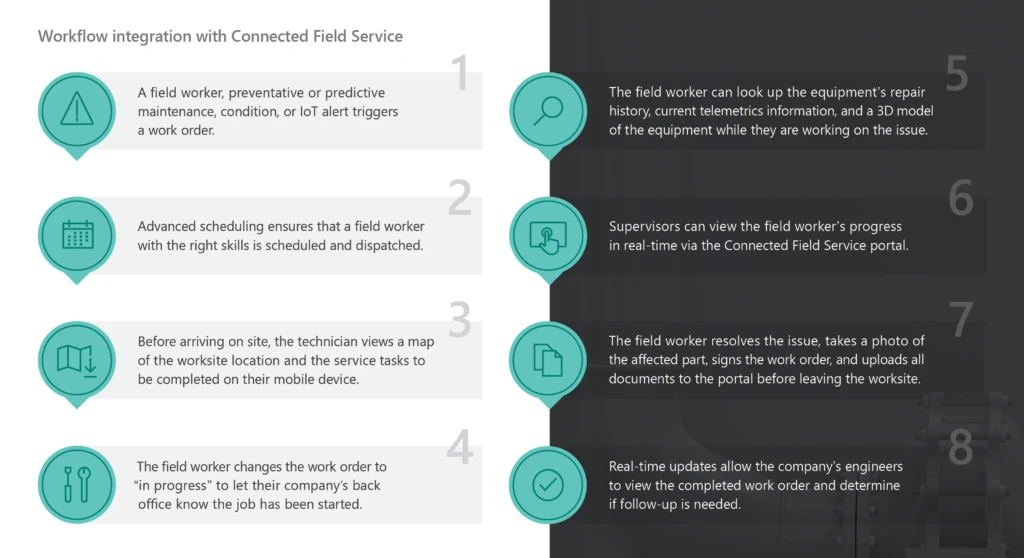
Connected Field Service in Oil & Gas and the Workflow of the Future
In 2018, the U.S. became a net exporter of oil and refined products, producing 12.5 million barrels per day as of October 2019 due to onshore exploration and production companies. While new finds are still an important part of the business, in recent years the industry has shifted its focus to breaking down silos and maximizing productivity. The companies that are doing this successfully today are not only leveraging the new technologies that have helped them survive industry lows, but they are scaling out their solutions and maximizing the technology across workflows.
The workflow of the future is at our fingertips, but chances are, your oil and gas organization is falling behind the technological curve and leaving trillions of dollars on the table. By designing and implementing new technologies across your company, you could be adding up to $2.5 trillion to the existing return on investment for the industry. This huge cost savings comes in large part from greater operational efficiencies across field workers, supply chain managers, and operations teams.
Today, data silos are creating challenges for oil and gas enterprises within the realm of integrated planning. With no holistic high-level oversight of operations, inefficiencies are practically expected. About 33.5% of oil and gas companies are currently addressing these silos by training their workforce in digital skills related to upstream. By joining them and adopting technologies like Connected Field Service, you and your teams can get a clearer picture of how each piece of the business affects company outcomes and start contributing to a better strategy.
Creating connected workflows
Inefficiencies lead to more inefficiencies, such as missed routine maintenance and double work. For example, your organization might have a technician that travels around the world twice a year to perform routine maintenance. By adopting a connected workflow, you minimize the amount of time that technician spends in transit, and maximize their time delivering strategic and proactive maintenance to prevent downtime across work sites.
In addition to maintenance efficiencies, Connected Field Service can reduce the time necessary to plan a well site by up to 50%. With centralized accessible information and analytics, connected IoT devices, and field workers using mobile devices to track, reference, and upload documents, the cost benefits are exponential. Further, Connected Field Service helps rationalize the number of applications a field worker has running at any given site and consolidates them into one platform. Your field workers can access the information they need quickly and efficiently, making them more productive. Integrating technology into your manual workflows can help automate routine tasks and streamline equipment service records, in addition to giving you a 360-degree view of your operations.
To show how technology can affect your traditional workflow, here’s a model of how Connected Field Service works in practice:

Connected Field Service consolidates all of the information field workers need into one centralized platform. The platform improves the uptime of assets and increases the utilization of resources in the field. This not only makes maintenance and repair operations easier to manage, but it helps the engineering teams onboard new technicians without the need for legacy technicians to be onsite, saving you resources and allowing more seasoned workers to spend less time on training new recruits.
With fewer human resources onsite, there’s an added increase in safety across the industry with the reduction of work trips and the number of workers laboring under dangerous conditions. This workflow upgrade also supports sustainability efforts and reduces the number of field hours required for short-term deployments.
Opening the door to the future
When you adopt a tech-forward mindset and start leveraging Connected Field Service across your operations, you also open the door to innovation, in your company and for the industry at large. With the right solutions, you get to build a new way of working that allows your field workers to leverage technologies like AI and IoT devices to gain even greater insights and build on their processes and solutions.
Tools like Microsoft Dynamics 365 Field Service are supporting a new generation of oil and gas workers. By empowering your field workers with technology and connected tools, you not only overcome costly inefficiencies and strengthen the field, you create a path to staffing and recruitment advantages. Within an ever-changing industry, agility is the key to success. When you’ve got a fine-tuned workflow and full visibility of processes across the organization, you can adapt quickly to changes in the field and in the market. The future of the oil and gas industry belongs not only to us, but to those who choose to devote their careers to it, and by leveraging the next stage of field service technology, you forge a stronger path to what lies ahead.
To learn more about how technology can shape the future of oil and gas, read our e-book: Transforming Upstream Oil and Gas Operations with Business-driven Purpose




